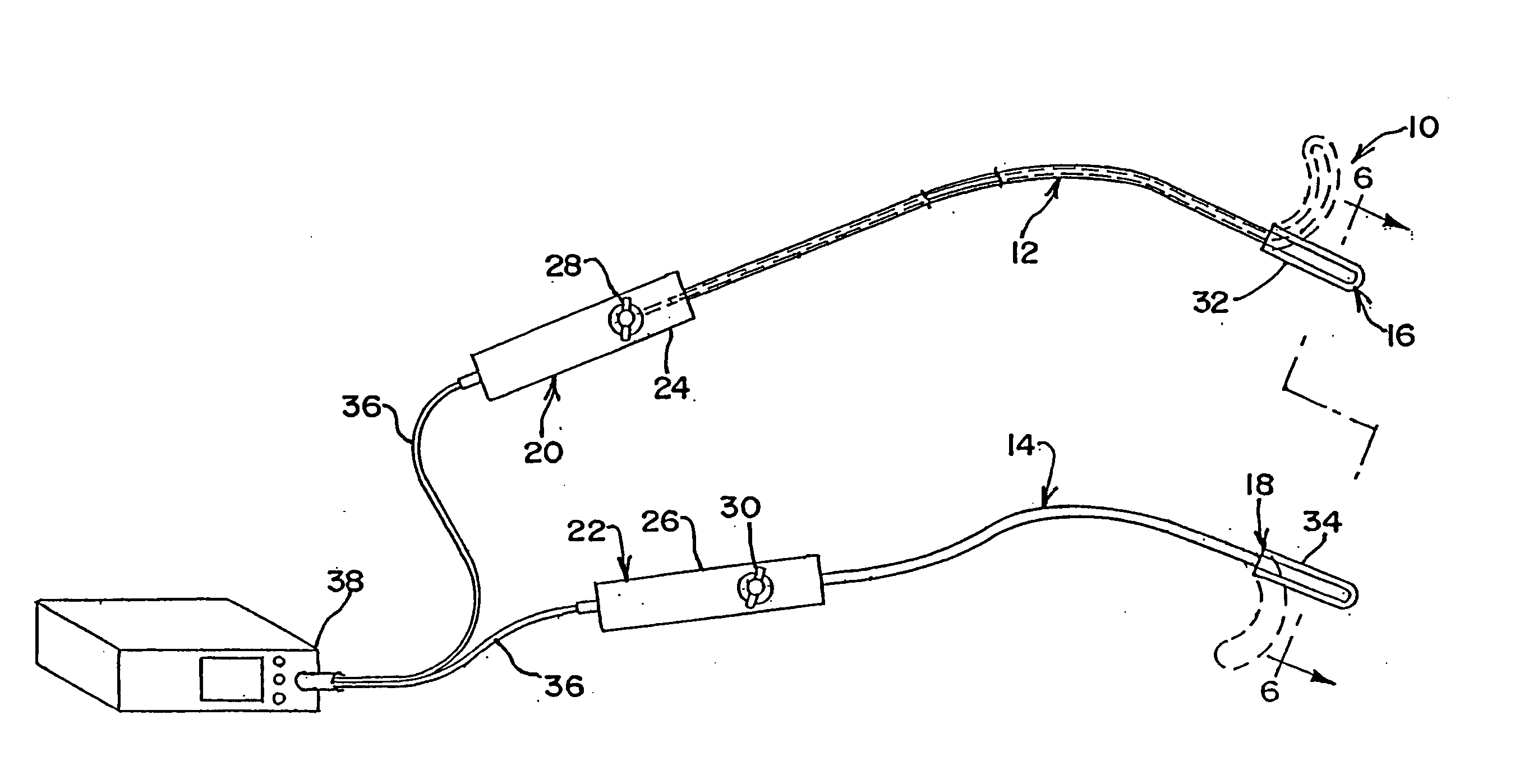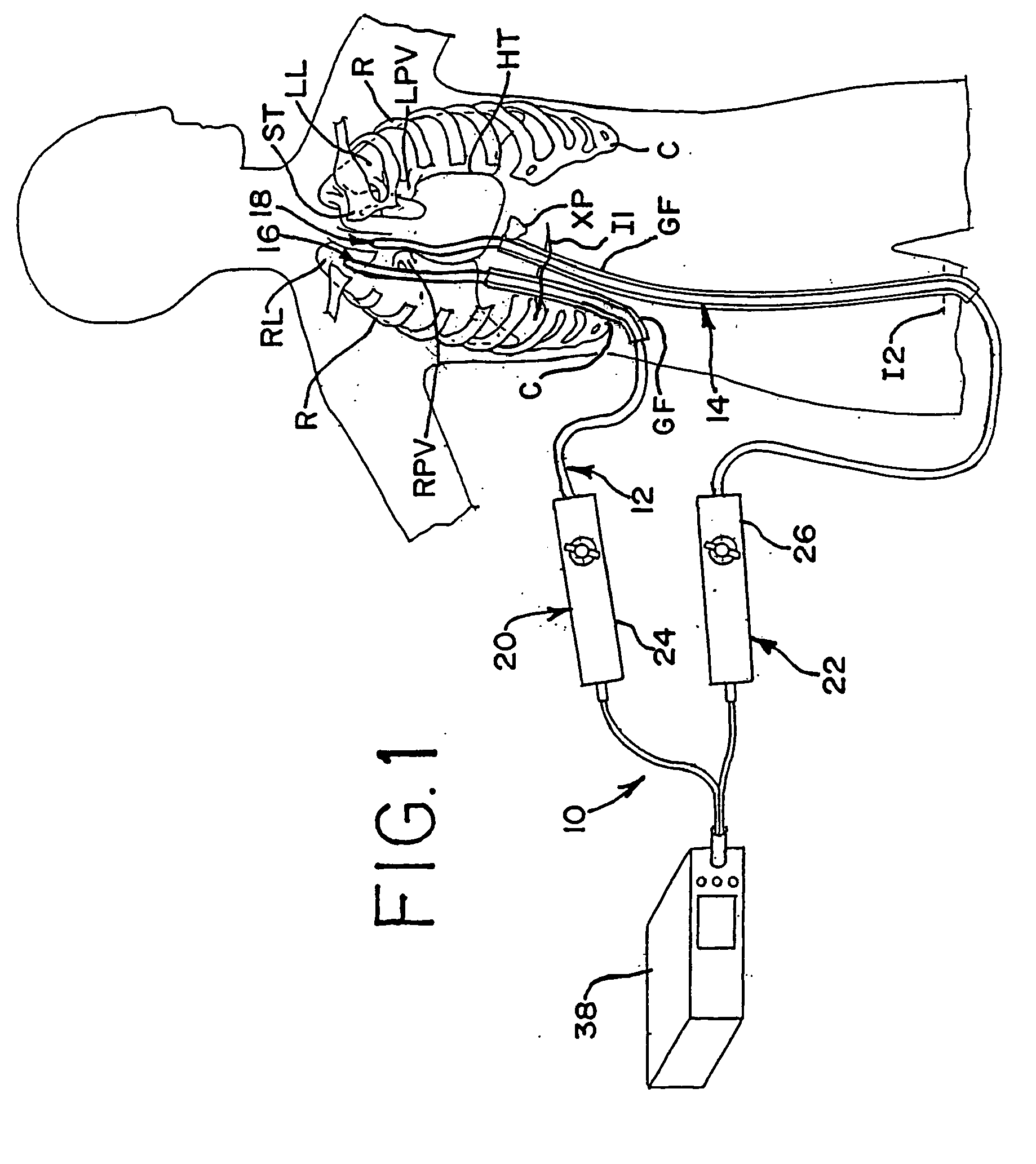Magnetic catheter ablation device and method
a magnetic catheter and ablation device technology, applied in the field of magnetic catheter ablation device and method, can solve the problems of difficult positioning of difficulty in precisely locating aberrant tissue, and difficulty in locating catheter and associated electrode or probe, etc., to facilitate the positioning of the second body, increase the magnetic attraction, and facilitate the alignment of the body
- Summary
- Abstract
- Description
- Claims
- Application Information
AI Technical Summary
Benefits of technology
Problems solved by technology
Method used
Image
Examples
first embodiment
[0084] In accordance with a more specific aspect of the invention, FIGS. 3-5 illustrate various views of the distal ends 16 and 18 of the apparatus. In FIG. 3, first and second bodies 12 and 14 have an exterior surface which defines an interior cavity and each body defines a corresponding axis A along its length. The shape and orientation of the bodies may vary apart from that shown in the views. By way of example and not limitation, the transverse shape of the bodies, which is shown in FIG. 4 as circular, may also be oblong or elliptical, as shown in FIGS. 8 and 20, square or rectangular, as shown in FIG. 6, arcuate, or other geometries, such as the examples shown, not by way of limitation, in FIGS. 12, 14, 23-24 and 26-28 which utilize planar, concave or convex contours, or a combination thereof on the surface or surfaces of the apparatus which contact the layer tissue. Other shapes or geometries are also possible.
[0085] In FIG. 3, the distal end 16 of the first body 12 further in...
third embodiment
[0103]FIGS. 7 and 8 show the apparatus 120. Each of the first and second bodies, respectively indicated at 122 and 124, have sources of magnetic force and magnetically attractive elements, generally indicated by respective reference numbers 126 and 128 and, in this embodiment, are each comprised of electromagnets which have lines of magnetic force, as shown in FIG. 10, upon activation by the current source.
[0104] The embodiment of FIGS. 7 and 8 is similar to the first embodiment of FIGS. 3-5 except that the coil wires of each electromagnet are disposed along an axis which is transverse to the axis A of each distal end, respectively indicated at 130 and 132. The electromagnets in each distal end 130 and 132 are spaced relative to each other along the body axis. Ablation members 134 are also spaced from one another along each distal end and are generally, but not exclusively, aligned with respective electromagnets. The ablation members 134 are positioned in the upper and lower surface...
fourth embodiment
[0107] Turning now to FIGS. 11-12, the apparatus generally indicated at 140 is shown having first and second bodies, respectively 142 and 144 (FIG. 12) with corresponding distal ends 146 and 148. A respective source of magnetic force 150 and a magnetically attractive element 152 are each in the form of at least one electromagnet. Each electromagnet is disposed in a yet further orientation than those previously described above. Each of the distal ends of the first and second bodies are identical to one another and, as such, only one will be described.
[0108] At least at the distal end 148 of the second body 144 the body has a transverse shape which includes a planar surface facing the tissue layer and a convex surface facing away from the tissue layer. Relative to the axial direction of the body shown in FIG. 11, the electromagnets 152 are oriented in several spaced rows carried by the distal end. As shown in FIG. 12, each row has a coil wire which is curved approximately 180 degrees ...
PUM
 Login to View More
Login to View More Abstract
Description
Claims
Application Information
 Login to View More
Login to View More - R&D
- Intellectual Property
- Life Sciences
- Materials
- Tech Scout
- Unparalleled Data Quality
- Higher Quality Content
- 60% Fewer Hallucinations
Browse by: Latest US Patents, China's latest patents, Technical Efficacy Thesaurus, Application Domain, Technology Topic, Popular Technical Reports.
© 2025 PatSnap. All rights reserved.Legal|Privacy policy|Modern Slavery Act Transparency Statement|Sitemap|About US| Contact US: help@patsnap.com



